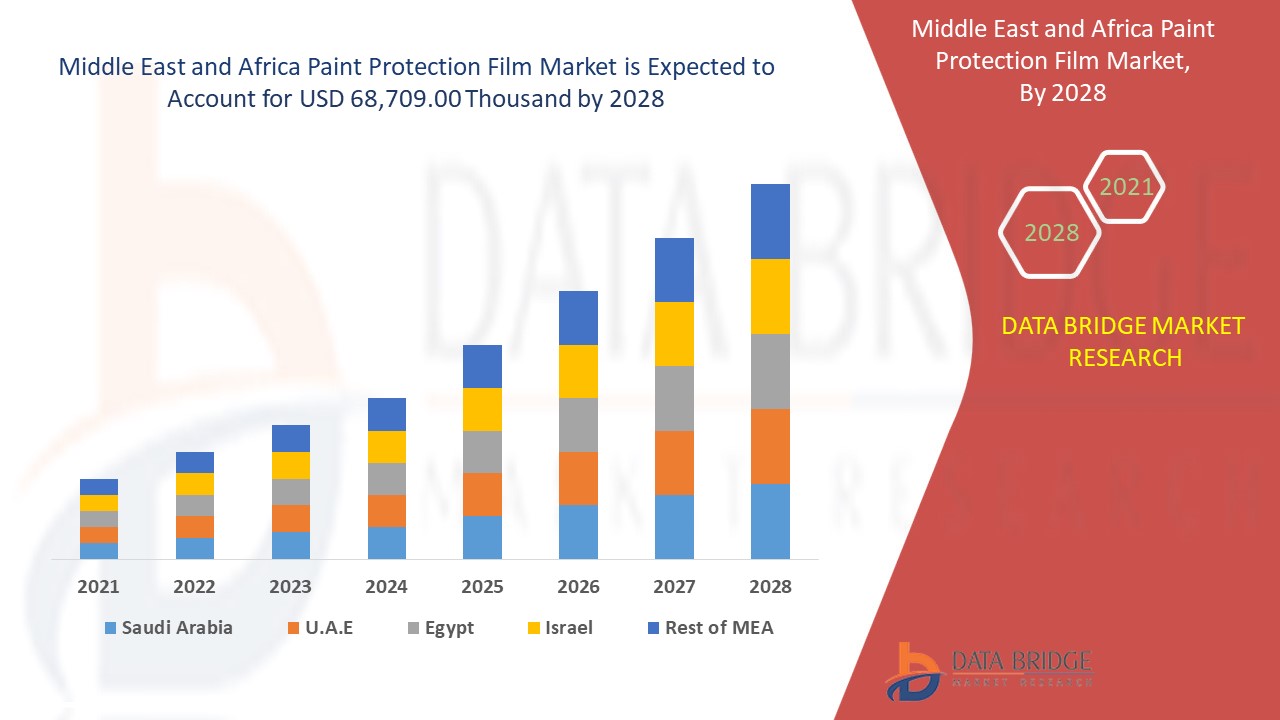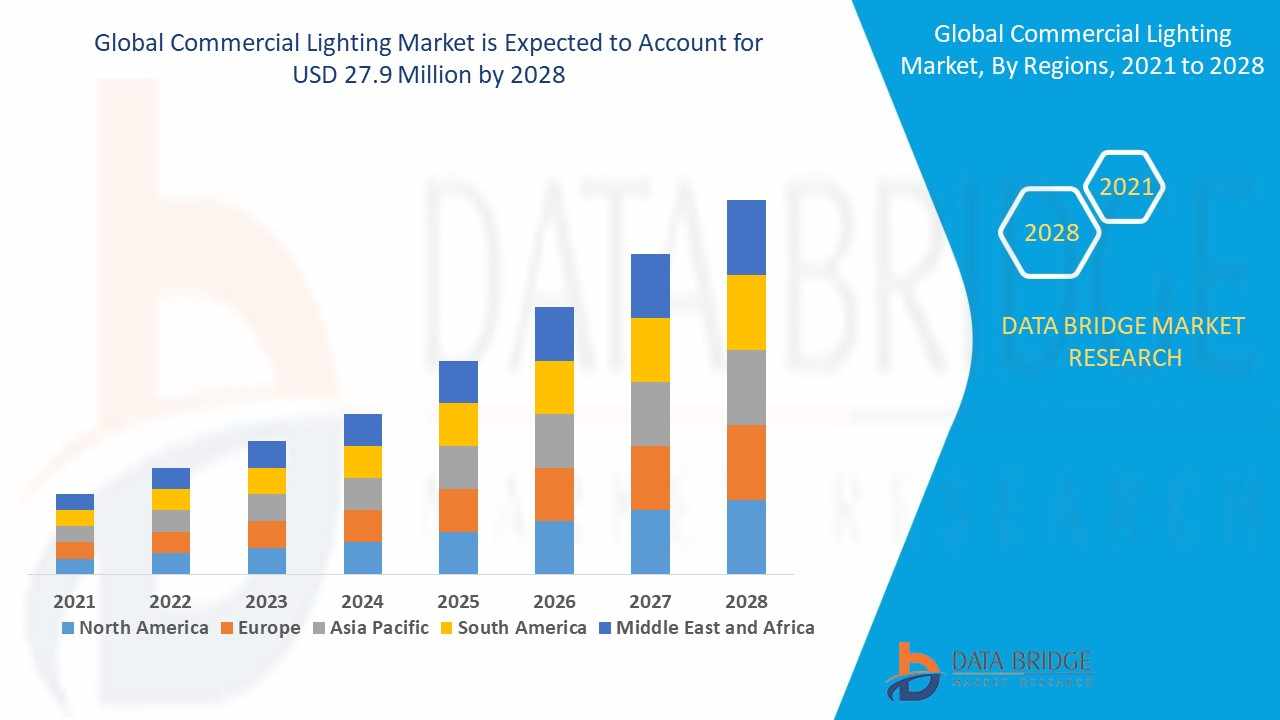The automotive and luxury goods sectors in the Middle East and Africa (MEA) are experiencing a significant transformation, with a rising emphasis on vehicle aesthetics, longevity, and overall asset preservation. In this dynamic environment, Paint Protection Film (PPF) has emerged as a crucial solution, safeguarding valuable investments from the region's unique environmental challenges and daily wear and tear.
The Middle East and Africa paint protection film market are expected to gain market growth in the forecast period of 2021 to 2028. Data Bridge Market Research analyses that the market is growing at a CAGR of 5.1% in the forecast period of 2021 to 2028 and expected to reach USD 68,709.00 thousand by 2028.
Get the PDF Sample Copy (Including FULL TOC, Graphs and Tables) of this report @
Introduction to Paint Protection Film (PPF)
Paint Protection Film, often referred to as clear bra or clear mask, is a thermoplastic urethane film applied to painted surfaces of new or used vehicles to protect the original paint from stone chips, bug splatters, minor abrasions, and environmental contaminants. Its self-healing properties, exceptional clarity, and durability have made it an increasingly popular choice among discerning vehicle owners. Beyond the automotive sector, PPF is also finding applications in aerospace, electronics, and other industries where surface protection is paramount.
Market Size: A Regional Overview
The MEA Paint Protection Film market is demonstrating robust growth, driven by increasing disposable incomes, a burgeoning luxury vehicle segment, and a growing awareness of the benefits of vehicle preservation. In 2024, the 72-inch paint protection film market in the Middle East & Africa alone was valued at approximately USD 1,751.8 thousand, with projections indicating a rise to USD 2,487.2 thousand by 2030, reflecting a Compound Annual Growth Rate (CAGR) of 5.9% from 2025 to 2030. While this region accounts for a smaller share of the global PPF market compared to Asia Pacific, it is identified as the fastest-growing regional market. Saudi Arabia, in particular, is a significant contributor to this growth, with its market expected to reach USD 27.06 million by 2032 from USD 17.85 million in 2024, growing at a CAGR of 4.42%. This upward trajectory underscores a fundamental shift in consumer perception, viewing PPF as a valuable investment rather than a mere accessory.
Market Share: Dominance of Automotive and TPU
The automotive and transportation sector undeniably holds the largest share within the MEA PPF market. In 2024, it accounted for a substantial 72.33% of the revenue in the 72-inch paint protection film market. This dominance is attributed to several factors: the increasing sales of new and used vehicles, the rising demand for luxury and high-performance cars, and a heightened consumer awareness regarding the maintenance of vehicle aesthetics and resale value. Within the automotive segment, passenger cars hold the largest share.
From a material perspective, Thermoplastic Polyurethane (TPU) is the dominant material in the PPF market, largely due to its superior flexibility, durability, and self-healing properties. In 2024, TPU films held an impressive 82.76% market share globally and are expected to maintain this dominance. Solvent-based systems also hold a significant share due to their superior adhesion and rust-repelling capabilities. Regarding finish, gloss finish PPF currently dominates the market, enhancing the luster and shine of vehicle paint.
Market Opportunities and Challenges
The MEA PPF market presents a compelling array of opportunities alongside its inherent challenges.
Opportunities:
Growing Automotive Industry: The continuous expansion of the automotive sector, including both new vehicle sales and the flourishing used car market, forms the bedrock of PPF demand.
Rising Awareness: Increased consumer education about the long-term benefits of PPF, such as protection against environmental damage, stone chips, and minor abrasions, is fueling adoption. This awareness is amplified by social media and automotive enthusiast communities.
Luxury and High-End Vehicles: The significant presence of luxury and high-performance vehicles in the MEA region creates a strong demand for premium protection solutions like PPF, as owners prioritize preserving the pristine condition and resale value of their valuable assets. The UAE, for instance, shows a marked interest in PPF for luxury cars due to its harsh climate.
Technological Advancements: Innovations in self-healing films, enhanced UV resistance, anti-yellowing properties, and improved clarity are constantly expanding the appeal and effectiveness of PPF, attracting new customers. The integration of ceramic coating technology and even graphene-infused coatings offers superior gloss, hydrophobicity, and UV resistance.
Expansion into Other Industries: Beyond automotive, the aerospace and defense sector, as well as the electrical and electronics industries, represent emerging opportunities for PPF applications, providing protection for high-value surfaces and components.
Aftermarket Growth: The strong aftermarket for vehicle customization and detailing services provides a significant avenue for PPF installation, with many consumers opting for protection after purchasing their vehicles.
Challenges:
High Initial Cost: The relatively high cost of PPF materials and professional installation can be a barrier for some consumers, especially for mid-range vehicle segments.
Installation Complexity: Proper PPF installation requires skilled labor and precision. Imperfections during installation can lead to bubbles, creases, or poor adhesion, impacting the film's appearance and performance.
Durability and Maintenance Issues: While modern PPF is highly durable, low-quality films or prolonged exposure to harsh UV rays can lead to yellowing or discoloration over time. Improper cleaning or the use of harsh chemicals can also damage the film.
Competition from Alternatives: Ceramic coatings, car waxes, and sealants offer alternative protection solutions, although they typically do not provide the same level of physical impact protection as PPF.
Limited Awareness in Certain Segments: While awareness is growing, some consumers in developing markets or specific vehicle segments may still be unfamiliar with the benefits of PPF.
Market Demand
The demand for Paint Protection Film in the MEA region is primarily driven by the strong desire among vehicle owners to preserve the aesthetic appeal and value of their automobiles. The harsh environmental conditions, including intense heat, sandstorms, and high UV exposure, particularly in the Gulf region, heighten the need for robust exterior protection. Consumers are increasingly viewing PPF as a critical investment to safeguard their vehicles from scratches, chips, and environmental degradation, ensuring a longer-lasting, showroom-quality finish. The rising sales of luxury and premium vehicles further amplify this demand, as these owners are more inclined to invest in top-tier protection solutions. Beyond new vehicle owners, the growing used car market also contributes to demand, as individuals seek to restore and protect the appearance of their pre-owned vehicles.
Market Trends
Several key trends are shaping the evolution of the MEA Paint Protection Film market:
Self-Healing Technology: The advancement of self-healing properties in PPF is a major trend. These films can automatically repair minor scratches and scuffs when exposed to heat, significantly extending the lifespan and maintaining the pristine appearance of the protected surface.
Enhanced Durability and UV Resistance: Manufacturers are continuously innovating to improve the longevity, clarity, and resistance of PPF to yellowing and discoloration caused by prolonged UV exposure.
Hydrophobic and Oleophobic Properties: New PPF formulations are incorporating hydrophobic and oleophobic coatings, making the film highly repellent to water, dirt, and oil. This simplifies cleaning and helps maintain a cleaner appearance.
Matte and Satin Finishes: Beyond the traditional gloss finish, there's a growing demand for matte and satin PPF options, allowing vehicle owners to achieve a customized, unique look while still benefiting from comprehensive paint protection.
Eco-Friendly and Sustainable Films: With increasing environmental consciousness, there is a push towards the development of PVC-free, biodegradable, and low-VOC (Volatile Organic Compound) PPF solutions. This trend aligns with global sustainability efforts and appeals to environmentally aware consumers.
Technological Integration (Future Potential): Emerging concepts like graphene-infused PPF, smart PPF with embedded micro-sensors for real-time monitoring of environmental conditions, and AI-enhanced custom application techniques are on the horizon, promising even more advanced protection and personalized solutions.
Expansion of Professional Installation Networks: The growth of specialized detailing studios and certified installers ensures high-quality application, which is crucial for optimal PPF performance and customer satisfaction.
The Middle East and Africa Paint Protection Film market is poised for continued expansion, driven by a confluence of economic growth, rising consumer sophistication, and continuous technological innovation. As the region's automotive and luxury markets mature, the demand for premium surface protection solutions will only intensify, solidifying PPF's position as an indispensable investment for preserving aesthetic brilliance and long-term value.
Contact Us:
Data Bridge Market Research
US: +1 614 591 3140
UK: +44 845 154 9652
APAC : +653 1251 975









Write a comment ...